Test 1
Which of the following is not one of the features of technical documents?
Writer-centeredness
Clear organization
Readable style
Effective visuals
One of the purposes of technical writing is to enable people to perform a task or follow a
procedure, that is, to __________ your readers.
suggest
instruct
persuade
inform
When writing a technical document, keep two audiences in mind. Most documents are
geared to an immediate audience of readers. This is your __________ audience.
semitechnical
nontechnical
primary
secondary
________ are those with no specialized training, who look for the big picture instead of
complex details. They expect technical data to be translated into words most people
understand.
Experts
Audiences
Laypersons
Informed persons
The most emphatic location in a pragraph is the __________ sentence.
middle
last
first
second
__________ is like trying new paint: you do not know whether you like the color until you
see it on the wall.
Revising
Editing
Planning
Drafting
�
The purpose of my document is to __________ company employees of the new absentee
policy and to __________ them on how to follow the procedures properly.
suggest; inform
inform; instruct
persuade; suggest
instruct; persuade
In most of your writing, you will carry out the task in a process consisting of five steps:
planning, drafting, revising, editing and __Proofreading________.
Assessing your audience’s technical background is essential before deciding whether
your document should be highly technical __Semitechnical_________, or nontechnical.
Clear writing means that the sentences can be understood in ____one______ reading.
Actually almost every day, we make decisions or
__technical__________ information.
take actions that depend on
To help your audience spend less time reading, you must spend more time
__Processing__ ( error ) revising_
fluent, and
appropriate in tone.
is clear, concise,
for a style that
�
Test 2
The principle of __________ means that related items should be grouped together.
proximity
repetition
contrast
alignment
The principle of __________ is that you should treat the same kind of information in the
same way to create consistent patterns.
repetition
contrast
alignment
proximity
The principle of __________ works in several different ways in technical documents, such
as large type with small type, a cool color with a warm color, and etc.
contrast
alignment
repetition
proximity
The principle of __________ is what tells the reader that the invisible line connecting the
text is much stronger.
proximity
alignment
repetition
contrast
We often use __________ tables to compare exact values.
prose
summary
numerical
appendix
__________ charts are used to depict how the phases of a project relate.
Pie
Organization
Tree
Gantt
�
Which of the following is serif typeface?
Helvetica
Tahoma
Arial
Times New Roman
The four basic principles of __design________ are proximity, alignment, repetition and
contrast.
All typefaces are divided into two broad categories: serif and ____sans______ serif.
Headers and __footers________ appear
in the top and bottom page margins,
respectively to provide chapter or article titles, authors’ names, dates, or other publication
information.
�
Test 3
Which of the following is the most suitable way for communication between people within
an organization?
Messaging
Microblogs
Memo
Emails
Which of the following is NOT a reason for using moderately formal tone for workplace
communication?
Your documents may be read by your boss.
Your documents will be read by people on the move.
Your documents are legally the property of the organization for which you work.
Your documents may appear in a court of law.
Which of the following may hinder goodwill and communicate ineffectively?
Sloppy appearance.
Conventional format.
Logical organization.
Concise language.
Text messages can .
save more time compared with telephone call
allow the writer to deal with more than one task
increase intimidation
attach other files
Text messages may have some potential problems EXCEPT .
employee misuse
easy documentation
lost productivity
security issues
Which of the following statements is FALSE?
Abbreviations can help build rapport among colleagues.
Abbreviations can help people exchange information quickly.
Abbreviations can be used when the readers can understand such abbreviations.
Abbreviations can be used to avoid misunderstanding.
�
Which of the following is NOT an advantage of email?
Email is very formal, including detailed attachments for professionals.
Email can be easily stored and forwarded.
Email provides a company with extensive records for future reference.
Email is useful when people are in different time zones.
Which of the following is the best subject line?
How are you?
Hello
Inquiry about Sunday Training
IT’S IMPORTANT
If you want to convey your messages effectively, you should .
put the readers’ levels of knowledge into consideration
establish friendship with your readers in advance
communicate more with high-tech readers
follow the email policy of the company your reader is working with
Which of the following is NOT a key point in memos?
Introduction.
Discussion.
Complimentary closing.
Identification lines.
Which of the following can make the memo more reader-friendly?
Boldfacing.
Headings.
Graphics.
All of the above.
If you want to write an effective memo, you should NOT .
keep it brief and to the point
use visuals to display information
provide sufficient information
address more than one topic
�
Test 4
In a chronological résumé, what is most recent should be listed last. ×
In a functional resume, sections are presented in priority order—from least important to
most important. ×
Skills summary should be placed early in the resume to make your major qualifications
stand out.√
A person with limited work experience should write his/her resume in the following order:
Contact information – Objectives – Experience – Education – Professional memberships
and affiliations - Certifications – Skills - Awards and honors. ×
A chronological resume clearly shows an applicant’s education and career development
over time. √
One of the purposes of a cover letter is to provide more details for the information in your
resume. ×
A recent graduate might want to present his/her education before the work experience in
the cover letter. √
In the education paragraph of a cover letter, an applicant should discuss all the skills and
knowledge he/she has gained from the university or college. ×
In the employment paragraph of a cover letter, an applicant should explain how the
special skills gained from his/her previous work experience make him/her well-suited for
the position he/she is applying for. √
In the Objective section, you only need to state in which field you'd like to work. ×
Passive voice is usually used in describing positions or responsibilities in a resume. ×
�
The line spacing between items is important because it can make your resume appear
clearly organized. √
Sentence fragments are not allowed in a resume. ×
You use present perfect tense for jobs you held and present tense for jobs you currently
hold. ×
Some applicants write a summary in the beginning of a resume to summarize all that he is
writing in the following sections. ×
Test 5
Instructions spell out the steps required for completing a task or a series of tasks. √
If the instructions are for the technicians, plain language and a glossary for specialized
terms are really necessary. ×
Leaving out some articles, some pronouns and some verbs can make the instructions
short and brief, but somewhat difficult for readers to understand. √
A title page must consist of the topic, contact information, warranties and a graphic. ×
Compared with numbers, bullet points and letters are better choices for helping readers
locate steps. ×
Positive words, such as “Thank you” and “pleasure” may help achieve positive customer
contact. √
The imperative mood is often used in writing instructions, because it is more direct and
economical. √
�
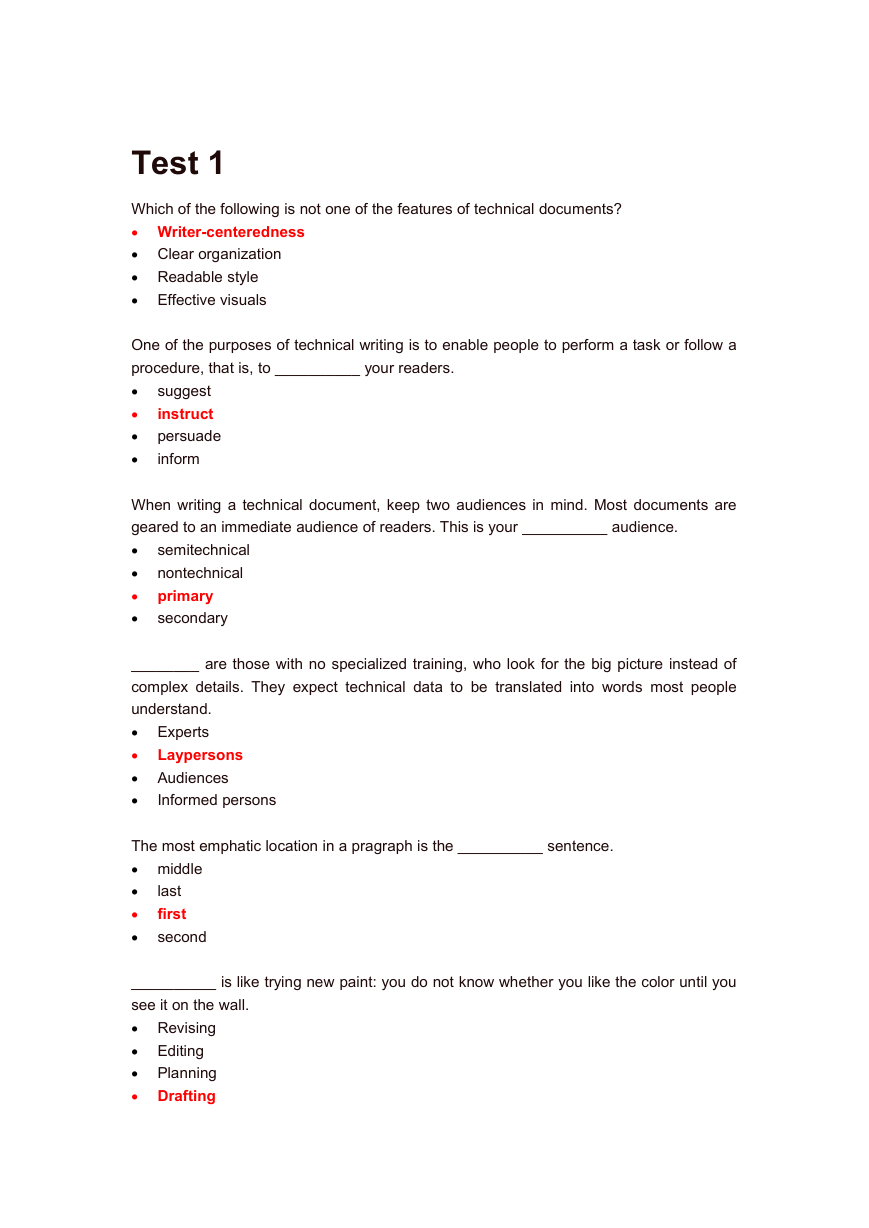
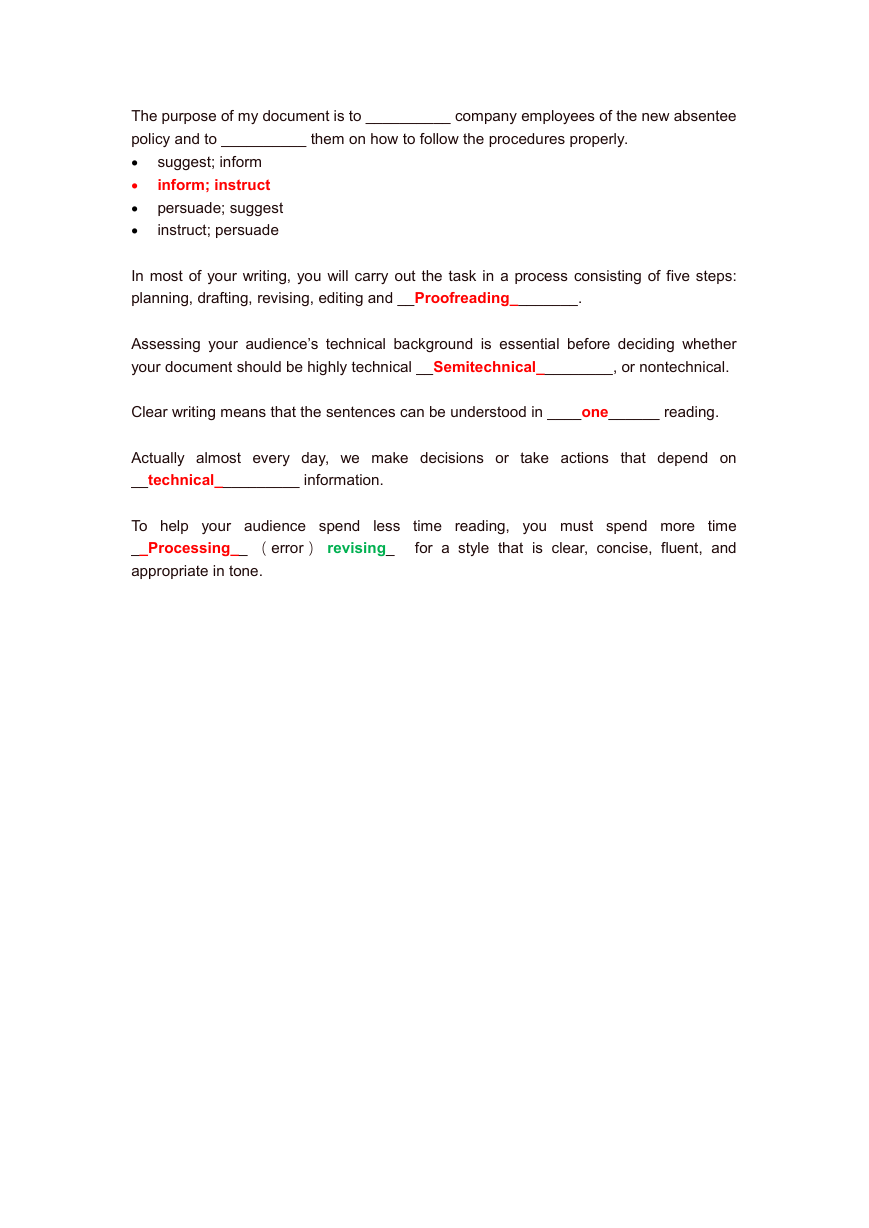
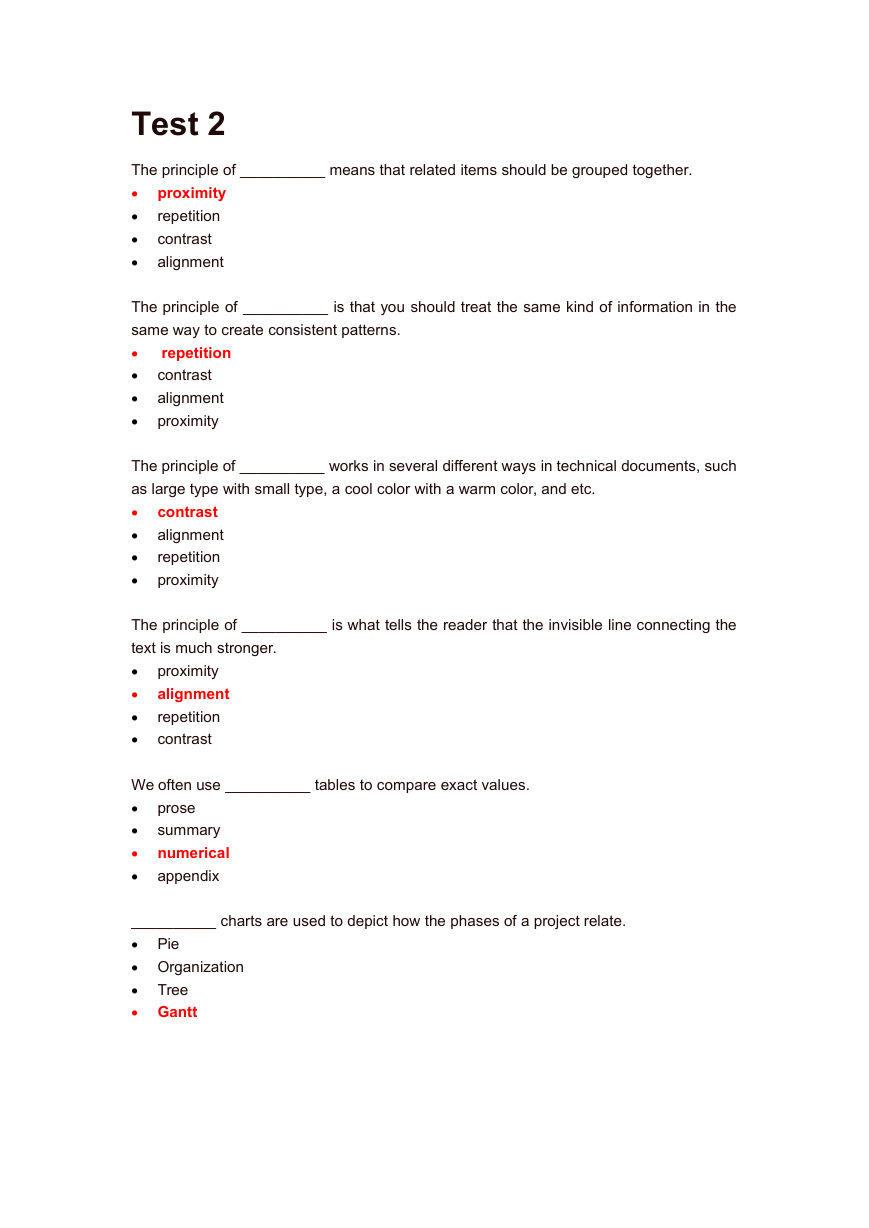

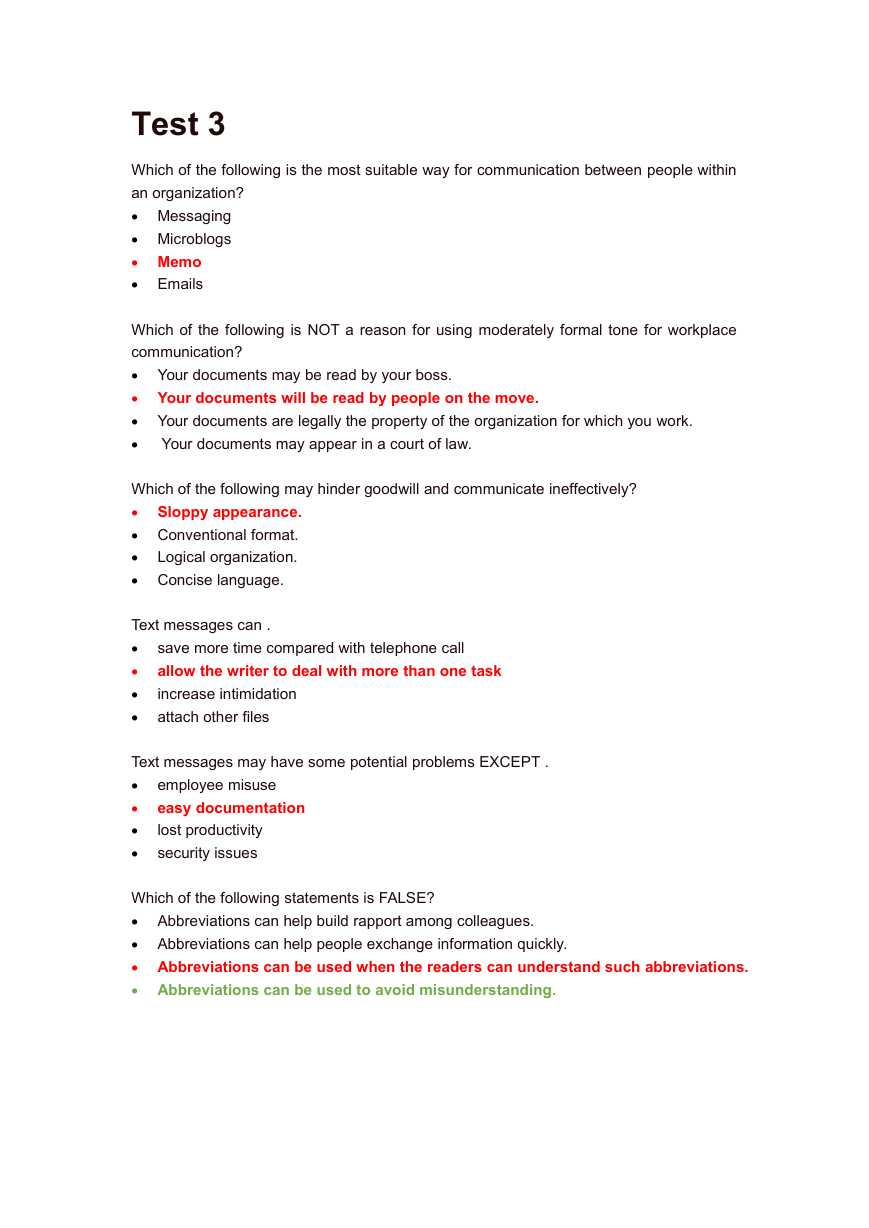
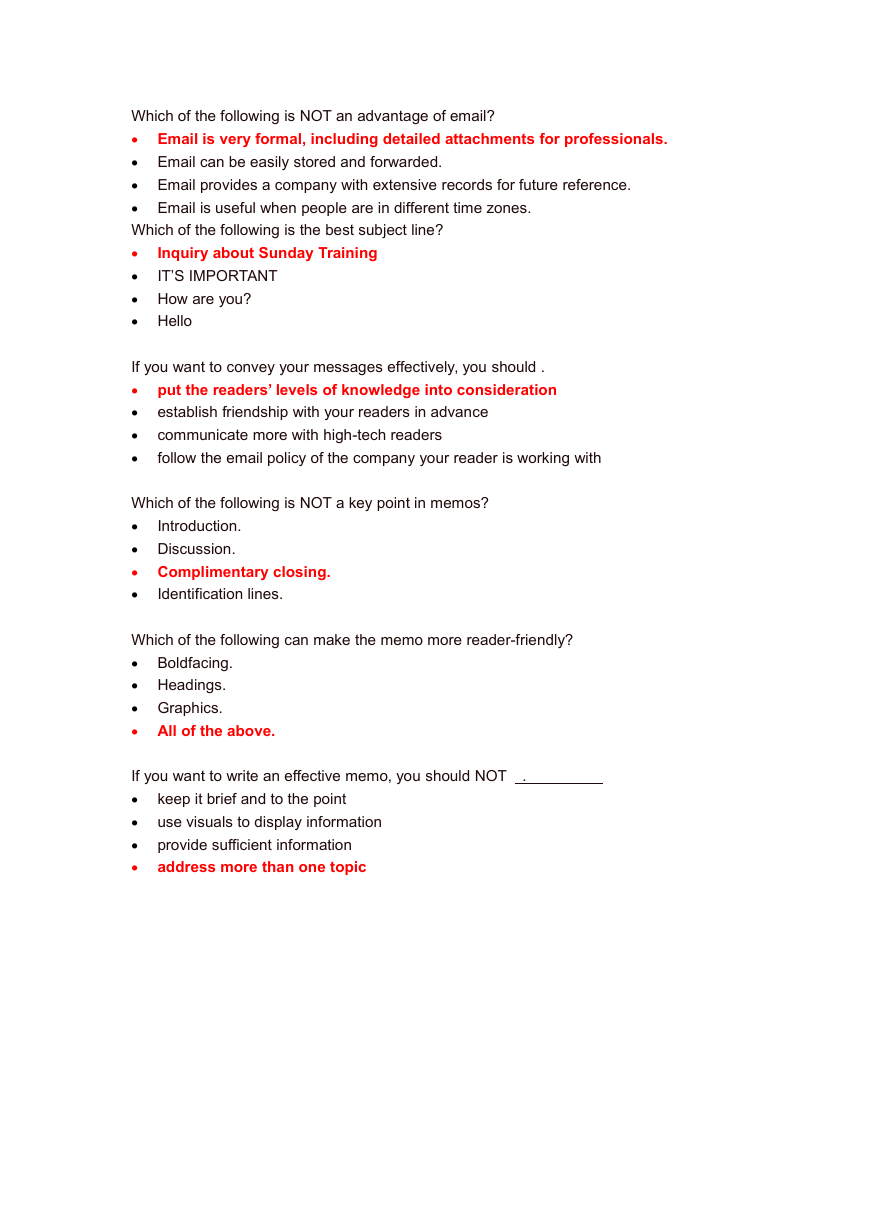
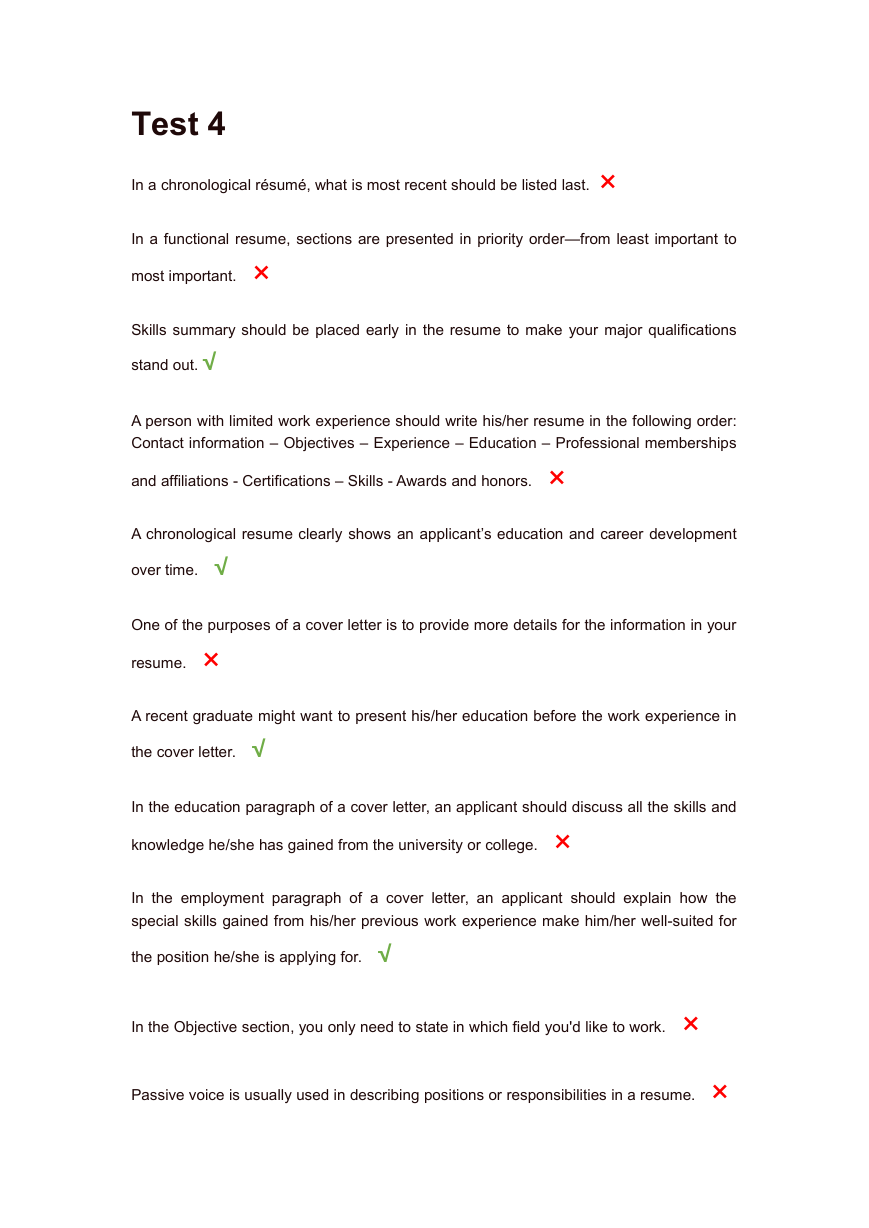
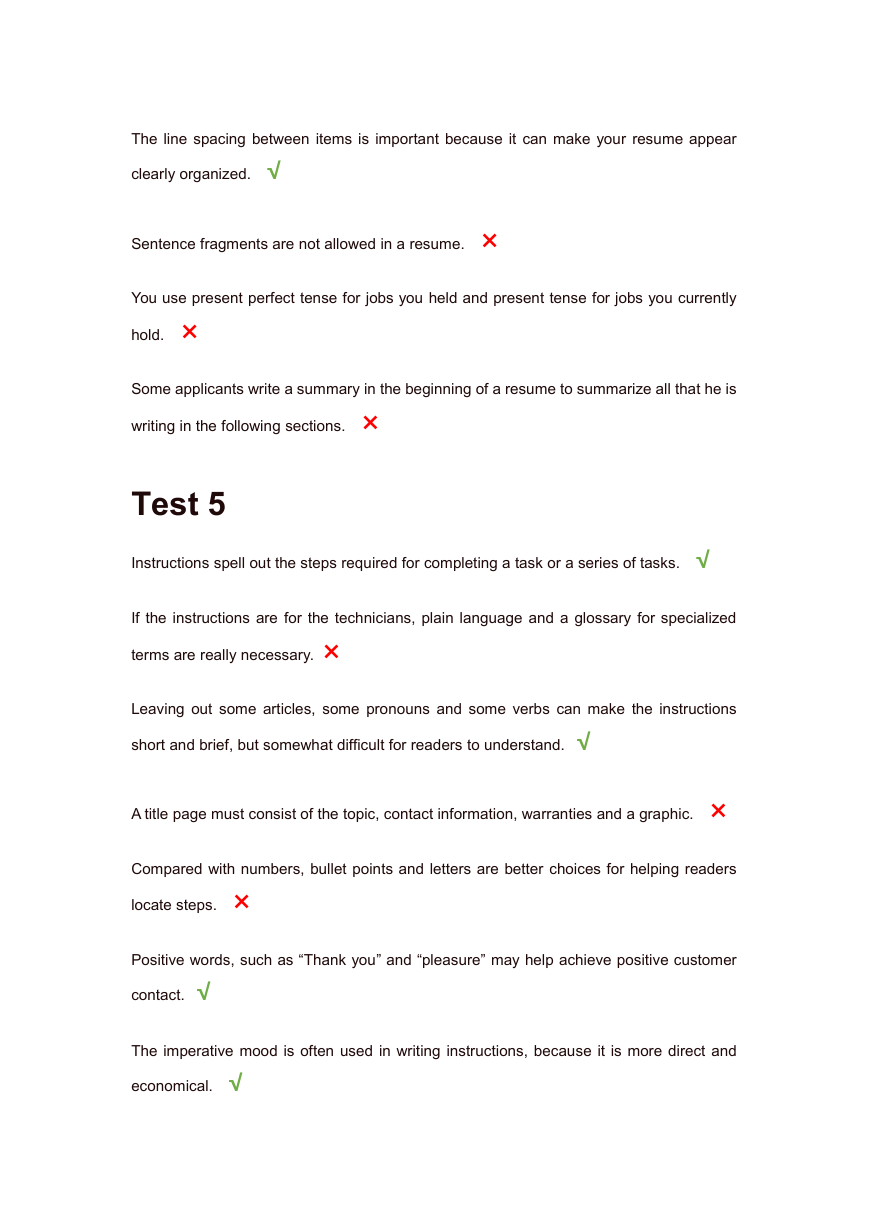








 2023年江西萍乡中考道德与法治真题及答案.doc
2023年江西萍乡中考道德与法治真题及答案.doc 2012年重庆南川中考生物真题及答案.doc
2012年重庆南川中考生物真题及答案.doc 2013年江西师范大学地理学综合及文艺理论基础考研真题.doc
2013年江西师范大学地理学综合及文艺理论基础考研真题.doc 2020年四川甘孜小升初语文真题及答案I卷.doc
2020年四川甘孜小升初语文真题及答案I卷.doc 2020年注册岩土工程师专业基础考试真题及答案.doc
2020年注册岩土工程师专业基础考试真题及答案.doc 2023-2024学年福建省厦门市九年级上学期数学月考试题及答案.doc
2023-2024学年福建省厦门市九年级上学期数学月考试题及答案.doc 2021-2022学年辽宁省沈阳市大东区九年级上学期语文期末试题及答案.doc
2021-2022学年辽宁省沈阳市大东区九年级上学期语文期末试题及答案.doc 2022-2023学年北京东城区初三第一学期物理期末试卷及答案.doc
2022-2023学年北京东城区初三第一学期物理期末试卷及答案.doc 2018上半年江西教师资格初中地理学科知识与教学能力真题及答案.doc
2018上半年江西教师资格初中地理学科知识与教学能力真题及答案.doc 2012年河北国家公务员申论考试真题及答案-省级.doc
2012年河北国家公务员申论考试真题及答案-省级.doc 2020-2021学年江苏省扬州市江都区邵樊片九年级上学期数学第一次质量检测试题及答案.doc
2020-2021学年江苏省扬州市江都区邵樊片九年级上学期数学第一次质量检测试题及答案.doc 2022下半年黑龙江教师资格证中学综合素质真题及答案.doc
2022下半年黑龙江教师资格证中学综合素质真题及答案.doc